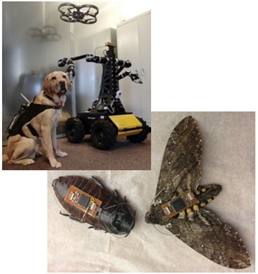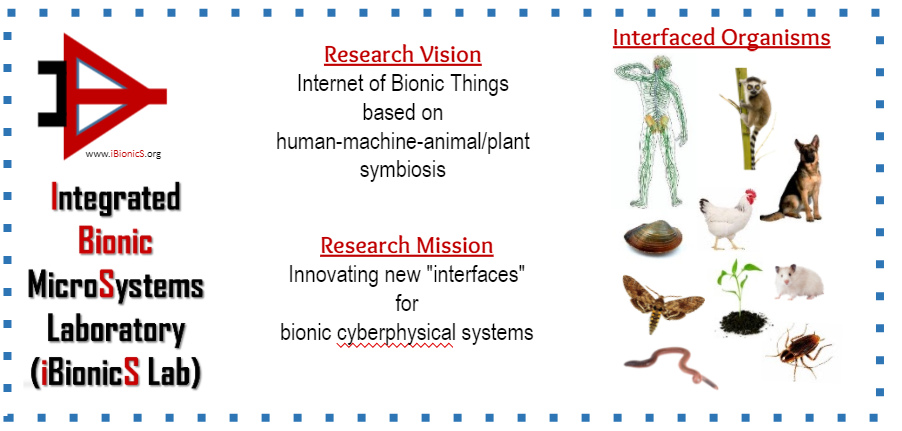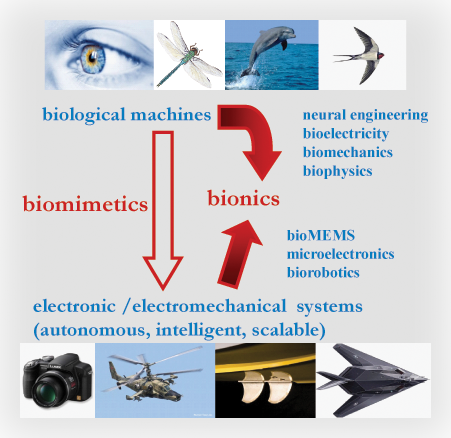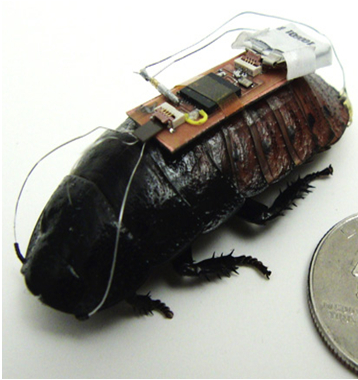Research Vision and Mission
What is Bionics?
One of the most efficient methods in the history of engineering has been “biomimetics” where researchers have looked at nature, learned from existing biosystems, and applied different engineering principles to mimic them when solving real life problems. As a result, many useful inventions have part of our daily lives. Despite our advances, we humans are still limited in our understanding and ability to mimic the more complicated properties of biological machines (such as autonomy and intelligence). To overcome these limitations, we follow an unconventional approach by fusing biological systems with artificial ones using novel engineering approaches. It is an interdisciplinary path that involves the intersection of neural engineering, MEMS, microelectronics, and biophysics.
Vision
At the dawn of new era based on cyber-physical systems where everything is connected through the Internet of Things, linking biological organisms to the cloud would solve real life engineering problems in innovative ways. This requires new system-level engineering approaches to fuse biological organisms with internet-connected synthetic electronic systems to enable the emergence of bionic microsystems. Subsequently, a quantum leap could be realized in our ever-lasting engineering struggle to mimic the relatively more complicated properties of biological machines, such as autonomy, intelligence, and biocomplexity observed across various scales. This can be achieved by directly collaborating with these biological organisms using cloud connected smart sensor and actuator systems. This would also provide a more ubiquitous and continuous connectivity to unlock the mysteries of such biological systems in general and would increase our awareness about the importance of their presence and role in our ecosystem. The major technical barrier in the way of such achievement is the inefficiency of state-of-art interfaces to transform a biological organism into a bionic cyber-physical system. The iBionicS Lab’s long term vision is to lead the field to lay the foundations of an Internet-of-Bionic-Things based on human-machine-animal/plant symbiosis by focusing on such “interfaces” with various biological organisms.



Mission

The iBionicS Lab’s dedication to innovate new system level approaches and define new out-of-the-box use cases to lay the foundations of Internet-of-Bionic-Things can be summarized in three domains:
MicroScale Sensors and Actuators (Research)
The iBionicS team has investigated the use of novel devices to augment sensor/actuator interfaces with tissue for more efficient neural, hemodynamic, muscular and dermal coupling with biological organisms. This investigation has been growing as five research focuses which resulted in a number of scholarly products. Some examples of the ongoing research include flexible electrodes for neural stimulation and recording in insects, surface modification of optical sources and detectors for low power biophotonic detection, textile fiber embedded sensors for wearable sensing, stretchable electrodes for plant leaves, and injectable biopotential and biophotonic sensors for canines.
Embedded Systems (Development)
The iBionicS team has interfaced such devices with electronic systems and incorporated these into wearable patches, headbands, wristbands, injectable capsules, animal harnesses and backpacks. This domain has helped iBionicS to bring the products of the Research Domain into real life and lead to the Deployment Domain. This domain also enabled several collaborations with the industry and led to iBionicS’ testbed leadership role at the NSF Engineering Research Center for Advanced Self Powered Systems of Integrated Sensors and Technologies (ASSIST Center). iBionicS embedded systems efforts include system-on-chip based biopotential recording front-ends, electrochemical impedance spectroscopy, functional near infrared spectroscopy, wireless energy and data transfer.
Application Testbeds (Deployment)
The iBionicS team combines the Research and Development Domain outputs and deploys these in various interdisciplinary research explorations to understand neural and physiological mechanisms underlying the behavior in various organisms at different biocomplexity levels and to achieve novel bionic cyberphysical systems. This results in five testbeds which have brought in millions of research dollars to let iBionicS to study animal/plant-machine-human interfaces through various research projects. The funding secured from the industry and government has not only fueled these testbeds to grow further but has also proven iBionicS synergistic capability to turn the testbeds into funded research projects. iBionicS lead several cross-disciplinary fields thanks to its interdisciplinary research partners collaborating in these domains. The organisms iBionicS currently study include (in an increasing length scale order) earthworms, insects (moths/ roaches), mussels, plants (soybean, maze, date palms), birds (chicken, turkey), canines, lemurs, and humans.